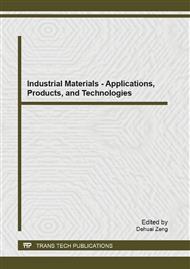[1]
GopikrishnanA. Reliabilityinferencebasedondegradationandtimetofailuredata: somemodels, methodsandefficiencycom parisons[D]. TheUniversityofMichigan, (2004).
Google Scholar
[2]
MeekerWQ, EscobarLA, LuJC. Accelerateddegradationtests: modelingandanalysis[J]. Technometrics, 1998, 40(2): 89~99.
Google Scholar
[3]
EghbaliG. Reliabilityestimateusingaccelerateddegradationdata[D]. RutgersUniversity, (2000).
Google Scholar
[4]
PengCY, TsengST. Mis-specification analysis of linear degradation models [J]. IEEETrans. on Reliability, 2009, 58(3): 444-455.
Google Scholar
[5]
Dasgupta, A, Pecht,M. Material Failure Mechanisms and Damage Models. IEEE Transactions on Reliability . (1991).
Google Scholar
[6]
Chenoweth H.B. Soft failures and reliability. Proceedings Annual Reliability and Maintainability Symposium . (1990).
DOI: 10.1109/arms.1990.67995
Google Scholar
[7]
Gerstsbackh,I. B, Kordonskiy K.B. Models of Failure(Translation from the Russian version). (1969).
Google Scholar
[8]
Nair V.N. Estimation of Reliability in Field-Performance Studies: Discussion. Technometrics. (1988).
Google Scholar
[9]
Misra R.B. Reliability assessment for static electricity meters. Metering and Tariffs for Energy Supply, 1999. Ninth International Conference on(Conf. Publ. No. 462) . (1999).
DOI: 10.1049/cp:19990125
Google Scholar
[10]
Yang, K, Xue,J. Continuous state reliability analysis. Proceedings Annual Reliability and Maintainability Symposium . (1996).
DOI: 10.1109/rams.1996.500670
Google Scholar
[11]
Zuo,M. J, Jiang R.Y., Yam R.C.M. Approaches for reliability modeling of continuous state devices. IEEE Transactions on Reliability . (1999).
DOI: 10.1109/24.765922
Google Scholar
[12]
Mroczkowski,R. S, Maynard J.M. Estimating the reliability of electrical connectors. IEEE Transactions on Reliability . (1991).
DOI: 10.1109/24.106764
Google Scholar
[13]
Thiagarajah K.R. Homogeneity tests for scale parameters of 2-parameter exponential populations under time censoring. IEEE Transactions on Reliability . (1995).
DOI: 10.1109/24.387385
Google Scholar
[14]
Chun Kin, C, Seraidaridia,C. I, Tortorella,M. Sequential sampling plans for early-life reliability assessment. Proceedings Annual Reliability and Maintainability Symposium . (1997).
DOI: 10.1109/rams.1997.571682
Google Scholar


